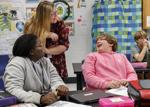MOUNT PLEASANT — Emily Zogas walked slowly through the rows of students in her sixth-grade science class at Thomas Cario Middle School surveying their work. The children were hunched over their desks, using crayons to draw on white paper.
They were learning about protists — microorganisms such as amoebas and diatoms. Their assignment was to create a pseudo-baseball card that included facts about their assigned organism and themselves.
Zogas stopped in front of Mari Mkrtchyan, a young girl sitting in the back row. Mari's paper was divided into a grid. In one row, she had correctly written that she liked to eat Hershey's Kisses and drew a picture of the candy in orange crayon. She was struggling, however, to find information on her laptop about what her protist ate.
Mari's family is from Armenia. She is what educators call a multilingual learner, which is another way of saying she is still learning English. She is one of a growing population of multilingual learners in South Carolina.
Mari is bright. She speaks five languages and dances for fun, but sometimes she needs extra assistance in class. To help with the assignment, Zogas showed her how to use Snap and Read. The technology purchased by the school reads highlighted passages of text out loud in English as many times as a student wants, to help them better understand the language.

The girl plugged her lime green headphones into her laptop and highlighted a paragraph about Euglena, her protist. Zogas smiled as she watched Mari nod along with the audio reading before moving on to help other students.
Adjusting lesson plans or teaching strategies to accommodate multilingual learners is just an example of how teachers at Thomas Cario and across Charleston County help these students. The district has one of the largest populations of multilingual learners in South Carolina. Two of its schools, Cairo and Charleston School of the Arts, have some of the highest-scoring multilingual learners in English and math at the elementary and middle school levels.
But the district didn’t always have a strong relationship with these students and their families.

Instructional teacher Cheryl McGee talks with sixth graders Tatyanna Evans and Preston Riffer during teacher Emily Zogas' science class Wednesday, March 22, 2023, at Thomas C. Cario Middle School in Mount Pleasant. Grace Beahm Alford/Staff
In March 2021, a federal investigation found the school district wasn’t communicating essential information to thousands of Spanish-speaking families, denying these children equal access to education programs and services. Charleston County settled with the U.S. Department of Justice and changed its practices. It now has an Office of Translation and Interpretation dedicated to communicating with multilingual families and has increased its number of bilingual parent advocates to improve community relations.
This type of family engagement is important because involving the families of multilingual learners in their education is the best way to ensure their academic success, according to experts.
The county’s strategic plan for supporting these students and communicating with their families provides a roadmap showing how other districts can support growing populations of multilingual learners.
In-house translation services
Stephanie Vickers, a translation and interpretation specialist from CCSD’s Office of Translation and Interpretation, arranged a dozen headphones on a small round table in the gym at E.B. Ellington Elementary School. It was March 17, St. Patrick’s Day, and the school was hosting a Fellowship and Families breakfast to inform parents about their children’s academic progress.
At the front of the gym was a stage with a speaker’s podium and projection screen advertising the event. The room was filled with round tables covered in green and white tablecloths. In the back, school staff put out bagels and other breakfast foods for families.

Students use their lockers between class Wednesday, March 22, 2023, at Cario Middle School in Mount Pleasant. Grace Beahm Alford/Staff
Vickers' job that day was interpreting what Principal James Dallas said on stage for Spanish-speaking families. When the parents arrived, they could take headsets and listen to Vickers when the principal was making his speech.
Vickers joined the Office of Translation and Interpretation shortly after it was formed two years ago. Before that she worked for an accounts receivable firm in he transportation industry and managed international accounts in Latin America. She then moved to CCSD where she worked as a bilingual secretary.
Getting the office up and running wasn’t easy. Most districts use outside translation services to communicate with families, said Susan Murphy, the state Title III coordinator with the S.C. Department of Education.
The first year was spent translating the district’s code of conduct and any flyers and information for families. Different COVID-19 variants were spreading through the country, forcing schools to go remote and extending staffers’ responsibilities beyond their typical job duties. Employees interviewed by The Post and Courier that year said they helped families with immunization forms, finding affordable housing and connecting with primary care providers.

Vickers also learned that interpreting differed from simply repeating what someone said in another language. It requires communicating what someone means rather than a word-for-word interpretation. A famous example of translation and interpretation going wrong is when Nikita Khrushchev, a Soviet leader in 1956, was said to have told Western ambassadors “we will bury you” instead of “we will live to see you buried.”
The statement shocked the Western world which took it as a nuclear war threat, and it increased tensions during the Cold War. But Khrushchev’s statement was translated too literally. What he actually meant was that communism would outlast capitalism. Vickers also had to communicate with families that spoke a variety of different Spanish dialects and understand a litany of niche cultural issues.
CCSD provided the office with coaching and other assistance. The district gives the office ongoing coaching and training support regarding ethics in the field of translation and interpretation services, specialized terminology in education, simultaneous and consecutive interpretation, and best practices for achieving accuracy in communication. Vickers began working at events like the one at E.B. Ellington. After one such event called Top Dog, a monthly recognition ceremony where teachers reward students for good performance, a parent approached Vickers and thanked her.
"She said, this is the first time I know why I'm clapping for my daughter because I know what's being said," Vickers said.
Families dressed in green trickled into the breakfast event. Parents filled seats at the tables. Children ran around the gym playing tag. Every set of headphones Vickers had arranged were soon gone.
Dallas took the stage and thanked the families for attending. The curtain lifted, and several students performed a song and dance in front of a multicolored sign that said, “Empower.” Afterward, parents lined up to get food. One woman broke out of line and thanked Vickers for her assistance.
Schools are friends, not foes
Amalia Chamorro monitored how multilingual learners were doing as part of her job as director of the education policy project at Unidos, the largest Hispanic civil rights and advocacy organization in the United States. The number of multilingual learners in the country increased by over 1 million students since 2000. Yet, despite their growing presence in schools, Chamorro noticed that their primary language skills were viewed by many educators as a problem to overcome rather than something that could benefit both them and their community.
This troubled her because multilingual learners often did as well as other students once they mastered English. The University of Chicago’s Consortium on School Research analyzed the long-term progress of 18,000 Chicago public school students who weren’t proficient in English in kindergarten. Researchers found that they performed similarly to students fluent in English and had better attendance and higher math scores, according to a December 2019 report.
But when the pandemic hit, much of the academic progress multilingual learners had made was threatened. These students often were from minority or low-income families — two groups that were disproportionately impacted by the pandemic. Many of their parents were not technology savvy, which made it hard for them to help their children when they had to learn remotely.

Instructional teacher Cheryl McGee helps Gabbie Chenoweth and Grayson Raines as she stops by Emily Zogas’ sixth grade science class Wednesday, March 22, 2023, at Thomas C. Cario Middle School in Mount Pleasant. Grace Beahm Alford/Staff
Chamorro’s group connected with community-based organizations to help these families during the pandemic. In some cases, they had to create outreach programs from scratch. They held educational technology seminars to show parents how to login into Zoom and check their email. They also assisted children with turning in their work digitally.
Families which received the educational technology training felt more comfortable communicating with their children’s schools when in-person classes resumed. Chamorro said that many of these families immigrated from countries with problematic bureaucracies and were suspicious of government bodies like schools.
Engaging with multilingual learners’ families is key to their academic success, according to a brief published in September 2018 by the Wisconsin Center for Education Research at the University of Wisconsin-Madison. But the engagement efforts must be tailored to the families' needs and be affirming and respectful. This includes celebrating the language these families speak at home and finding ways multilingual families can better a school community.
It also includes listening to families about what their needs are and advocating for them when necessary. Since the Office of Translation and Interpretation manages most of CCSD’s communication needs with these families, bilingual parent advocates have the time to form deep relationships with them and help them with non-school-related issues, giving these families support they may not have received in other school districts.
Beyond the classroom
Magaly Torres, a multilingual-learner program parent advocate for CCSD, became interested in helping form connections with Spanish-speaking families in Charleston early in her life. Torres was the daughter of migrant workers and learned English at an elementary school on Johns Island in the late 1990s and early 2000s.
“I did a lot of interpreting and translating because I was the only Spanish-speaking child on my grade level,” she said.
If a Spanish-speaking parent came to the school, she often was called to the administration office to help interpret. This went on until third grade, when there was an influx of other Spanish-speaking students. Torres saw firsthand the anxiety many of these parents felt coming into the school and their relief when they learned she could help them communicate with educators.

Torres became a bilingual parents advocate for the district after graduating from the College of Charleston with dual major in biology and Spanish. What she enjoys about the work is that it helps multilingual families with all aspects of their life.
Bilingual advocates created programs like Latino Family Literacy Project to make families feel more connected to their schools’ communities. It's a multi-week program to promote love of reading through bilingual, culturally relevant books and universal themes. As part of the program, families read different series of books written in both English and Spanish that tackle topics their children can relate to. One of the series focuses on a girl who comes to America from a different country and struggles to learn English.
The advocates also developed a program to help multilingual learners with their social-emotional needs. Children across the country experienced a mental health crisis during the pandemic, but multilingual learners faced obstacles their peers may not have experienced, according to a report the U.S. Department of Education released last April. Many multilingual families may have been hesitant to seek medical care for ailments or struggled to find a competent mental health provider who spoke their language. For some families who experienced trauma in their home countries, the pandemic triggered the re-emergence of horrible memories.
The advocates' program is for newcomer students who arrived in the U.S. in the past three years. It's called A New Sun, and focuses on helping students identify their emotions and learn different coping strategies.
A broader goal of these initiatives is to get families comfortable with the school system and advocating for their children.
“They can get intimidated coming into an institution or building that maybe hasn’t made them feel welcome in the past,” Torres said.
In addition to the programs, advocates work closely with individual families. One of the families Torres works with is from Guatemala. Two little girls are being raised by a single mother. When they came to CCSD, Torres helped them get school uniforms and supplies. She helped set their mother up with medical care providers for general medical needs. Now, the oldest of the two girls is in second grade. Her teacher said she is speaking English wonderfully.
More than just Spanish
Mari moved to the United States seven months ago. What she liked most was how kind everyone was in Charleston, especially her teachers and classmates. Her favorite subject was math because it has the smallest learning curve for her in English. But she struggled with science.
One thing she loved about Zogas' class was how she was willing to adjust her lessons to accommodate her, like when she showed Mari how to use Snap and Read. Mari also liked how Zogas incorporated pictures and drawings into her lesson plans. Earlier in the year when Zogas taught about different types of energy, she had students draw a farm and label forms of energy the farm used. It was supposed to be a single scene but she found that Mari understood the assignment better and was able to break it up. She drew a dozen small pictures of how different forms of energy were used in everyday life, drawing a person eating an apple to illustrate chemical energy and a boiling pot for thermal energy.
While CCSD multilingual students were predominantly from Spanish-speaking families, many — like Mari — spoke other languages.
Zogas said that even if a student is mostly proficient there might be some basic words in English they don’t know. For example, one student she taught didn't know the word for pencil. She often associates words with pictures during her classes to avoid confusion.
Bryan Coleman, the school’s interim principal, said that students at Cario speak 13 different primary languages, including Polish, Italian and Chinese. This reflects a new trend of more multilingual learners from non-Spanish speaking counties moving to Charleston and other areas in South Carolina.
The S.C. Department of Education received numerous inquiries last year about the influx of Afghan and Ukrainian students enrolling in schools, said Zach Taylor, the agency's team lead for Diversity, Inclusion and Access. Questions from districts ranged from whether it was OK to enroll the students mid-year or even mid-semester to how they could best support them. He theorized that more multilingual learners were coming to South Carolina from countries where Spanish wasn’t the primary language because of problems in those countries, such as the war in Ukraine.
To communicate with these families, CCSD uses technology like TalkingPoints, a two-way communications platform that can generate text messages on general communication topics in over 145 languages. It also has LangaugeLine, which provides over-the-phone interpretation support in 240 languages.
Mari used Snap and Read for the rest of the class on protists. By the end, she finished her baseball card filling it with pictures and information of what Euglena like to eat and different facts about the microorganism.
She turned her assignment in with a smile and headed to her next class.
No comments:
Post a Comment